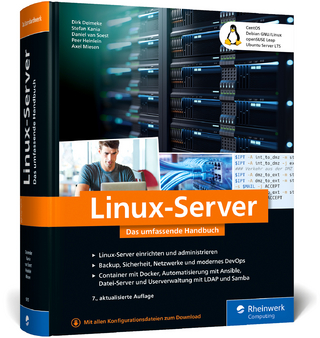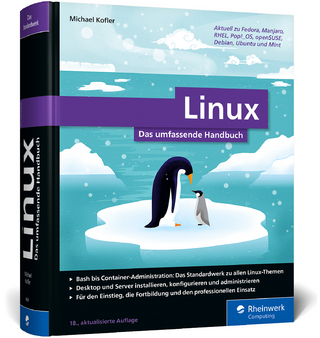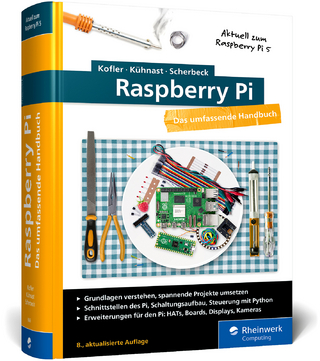
Docker Containers (includes Content Update Program)
Addison Wesley (Verlag)
978-0-13-413656-1 (ISBN)
- Titel ist leider vergriffen;
keine Neuauflage - Artikel merken
Whether on your laptop or a remote cloud, Docker can transform how you create, test, deploy, and manage your most critical applications. In Docker Containers, Christopher Negus helps you master Docker containerization from the ground up.
You’ll start out running a few Docker container images in Ubuntu, Fedora, RHEL, CoreOS, or Project Atomic. By the time you’ve finished, you’ll be deploying enterprise-quality, multi-container Kubernetes setups in modern Linux and cloud environments.
Writing for system administrators, software developers, and technology enthusiasts, Negus touches on every aspect of working with Docker: setting up containerized applications, working with both individual and multiple containers, running containers in cloud environments, and developing containers.
Teaching through realistic examples of desktop applications, system services, and games, Negus guides you through building and deploying your own Dockerized applications. As you build your expertise, you’ll also learn indispensable Docker best practices for building and integrating containers, managing Docker on a day-to-day basis, and much more:
• Understanding what Docker is and what you can do with it
• Installing Docker on standard Linux or specialized container operating systems such as Atomic Host and CoreOS
• Setting up a container runtime environment and private Docker Registry
• Creating, running, and investigating Docker images and containers
• Finding, pulling, saving, loading, and tagging container images
• Pulling and pushing containers between local systems and Docker Registries
• Integrating Docker containers with host networking and storage
• Building containers with the docker build command and Dockerfile files
• Minimizing space consumption and erasing unneeded containers
• Accessing special host privileges from within a container
• Orchestrating multiple containers into complex applications with Kubernetes
• Using super privileged containers in cloud environments
• Managing containers in the cloud with Cockpit
• Getting started with Docker container development
• Learning container build techniques from shared Dockerfiles
This book is part of the Pearson Content Update Program. As the technology changes, sections of this book will be updated or new sections will be added. The updates will be delivered to you via a free Web Edition of this book, which can be accessed with any Internet connection.
Christopher Negus is a bestselling author of Linux books, a certified Linux instructor and examiner, Red Hat Certified Architect, and principal technical writer for Red Hat. At the moment, projects Chris is working on include Red Hat OpenStack Platform High Availability, Red Hat Enterprise Linux Atomic Enterprise, Kubernetes, and Linux Containers in Docker format. As an author, Chris has written dozens of books about Linux and open source software. His Linux Bible, Ninth Edition, released in 2015, is consistently among the top-selling Linux books today. During the dotcom days, Chris’s Red Hat Linux Bible sold more than 250,000 copies in eight editions and was twice voted best Linux book of the year. Other books authored or coauthored by Chris include the Linux Toolbox series, Linux Toys series, Fedora and Red Hat Enterprise Linux Bible series, and Linux Troubleshooting Bible with Wiley Publishing. With Prentice Hall, Chris helped produce the Negus Software Solution Series. For that series, Chris wrote Live Linux CDs and coauthored The Official Damn Small Linux Book. That series also includes books on web development, Google Apps, and virtualization. Chris joined Red Hat in 2008 as an RHCE instructor. For that role, he became a Red Hat Certified Instructor (RHCI) and Red Hat Certified Examiner (RHCX). In 2014, Chris became a Red Hat Certified Architect (RHCA), with certifications in Virtualization Administration, Deployment and Systems Management, Cluster and Storage Management, and Server Hardening. In 2011, Chris shifted from his Linux instructor role back to being a full-time writer for Red Hat, which he continues to do today. Early in his career, Chris worked at UNIX System Laboratories and AT&T Bell Labs with the organizations that produced the UNIX operating system. During that time, Chris wrote the first official UNIX System V Desktop system manual and cowrote the Guide to the UNIX Desktop. For eight years, Chris worked closely with developers of the UNIX system, from UNIX System V Release 2.0 through Release 4.2.
Preface xv
Acknowledgments xxi
About the Author xxiii
Part I: Getting Going with Containers 1
Chapter 1: Containerizing Applications with Docker 3
Understanding Pros and Cons of Containerizing Applications 4
...An Application Running Directly on a Host Computer 4
...An Application Running Directly within a Virtual Machine 5
Understanding the Upside of Containers 5
Understanding Challenges of Containerizing Applications 7
Understanding What Makes Up Docker 8
The Docker Project 8
The Docker Hub Registry 9
Docker Images and Containers 10
The docker Command 11
Approaching Containers 13
Summary 14
Chapter 2: Setting Up a Container Run-Time Environment 17
Configuring a Standard Linux System for Docker 18
Configuring Ubuntu for Docker 18
Configuring Fedora for Docker 21
Configuring Red Hat Enterprise Linux for Docker 25
Configuring Other Operating Systems for Docker 27
Configuring a Container-Style Linux System for Docker 29
Configuring an Atomic Host for Docker 29
Configuring CoreOS for Docker 32
Summary 34
Chapter 3: Setting Up a Private Docker Registry 35
Getting and Starting a Private Docker Registry 36
Setting Up a Docker Registry in Fedora 37
Setting Up a Docker Registry in Ubuntu 40
Configuring a Private Docker Registry 43
Configuring the docker-registry Package 43
Configuring the registry Container 46
Understanding the Docker Image Namespace 46
Summary 48
Part II: Working with Individual Containers 49
Chapter 4: Running Container Images 51
Running Container Images Interactively 54
Starting an Interactive Bash Shell 54
Playing Some Character-Based Games 56
Running Administrative Commands Inside a Container 57
Running Containerized Services 59
Running a Containerized Web Server 59
Limiting Resources When Running Services in Containers 62
Running Privileged Containers 63
Summary 64
Chapter 5: Finding, Pulling, Saving, and Loading Container Images 65
Searching for Images 66
Searching for Images with the docker Command 66
Searching for Images on Docker Hub 69
Searching Other Repositories for Images 70
Pulling Images from Registries 73
Saving and Loading Images 76
Summary 77
Chapter 6: Tagging Images 79
Assigning Names to Images 80
Assigning Tags to Images 81
Assigning Repository Names to Images 83
Attaching a User Name to an Image 83
Attaching a Repository Name to an Image 85
Summary 86
Chapter 7: Investigating Containers 87
Inspecting Images and Containers 88
Inspecting an Image 88
Inspecting Base Images with docker inspect 89
Inspecting Application Images with docker inspect 90
Looking at the History of an Image 92
Inspecting Running Containers 92
Start a Container to Inspect 93
Inspect an Entire Container Configuration 94
Inspect Individual Container Attributes 99
Finding More Ways to Look into Containers 103
Using docker top to See Container Processes 103
Using docker attach to Interact with a Service Inside a Container 104
Using docker exec to Start a New Process in a Running Container 105
Using docker logs to See Container Process Output 106
Using docker diff to See How a Container Has Changed 106
Using docker cp to Copy Files from a Container 107
Summary 107
Chapter 8: Starting, Stopping, and Restarting Containers 109
Stopping and Starting a Container 109
Stopping and Starting a Detached Container 110
Starting and Stopping an Interactive Container 112
Restarting a Container 113
Sending Signals to a Container 114
Pausing and Unpausing Containers 115
Waiting for a Container’s Exit Code 116
Renaming a Container 117
Creating a Container 117
Summary 118
Chapter 9: Configuring Container Storage 121
Managing Storage for a Container 122
Using Volumes from the Host 122
Data Volume Container 123
Write-Protecting a Bind Mount 124
Mounting Devices 125
Mounting Sockets 125
Storage Strategies for the Docker Host 127
Attaching External Storage to a Docker Host 128
Summary 130
Chapter 10: Configuring Container Networking 133
Expose Ports to Other Containers 134
Map Ports Outside the Host 136
Map a Port from Linked Containers 136
Connect Containers on Different Hosts 138
Alternatives to the docker0 Bridge 139
Changing Network Mode for a Container 140
Examining Network Options 140
Changing the Docker Network Bridge 142
Summary 143
Chapter 11: Cleaning Up Containers 145
Making Space for Images and Containers 146
Removing Images 146
Removing Individual Images 147
Removing Multiple Images 148
Removing Containers 150
Removing Individual Containers 150
Removing Multiple Containers 152
Cleaning Up and Saving Containers 153
Cleaning Up and Saving an Ubuntu Container 153
Cleaning Up and Saving a Fedora Container 154
Summary 154
Chapter 12: Building Docker Images 157
Doing a Simple docker build 158
Setting a Command to Execute from a Dockerfile 161
Using the CMD Instruction 161
Using the ENTRYPOINT Instruction 162
Using the RUN Instruction 163
Adding Files to an Image from a Dockerfile 164
Exposing Ports from an Image within a Dockerfile 165
Assigning Environment Variables in a Dockerfile 166
Assigning Labels in a Dockerfile 167
Using Other docker build Command Options 168
Tips for Building Containers 169
Clean Up the Image 169
Keep Build Directory Small 169
Keep Containers Simple 170
Manage How Caching Is Done 170
Summary 171
Part III: Running Containers in Cloud Environments 173
Chapter 13: Using Super Privileged Containers 175
Using Super Privileged Containers in Atomic Host 176
Understanding Super Privileged Containers 176
Opening Privileges to the Host 177
Accessing the Host Process Table 177
Accessing Host Network Interfaces 178
Accessing Host Inter-Process Communications 179
Accessing Host File Systems 179
Preparing to Use Super Privileged Containers 180
Using the atomic Command 180
Installing an SPC Image with atomic 182
Getting Information about an SPC Image with atomic 182
Running an SPC Image with atomic 183
Stopping and Restarting an SPC with atomic 184
Updating an SPC Image 184
Uninstalling an SPC Image 185
Trying Some SPCs 185
Running the RHEL Tools SPC 186
Running the Logging (rsyslog) SPC 187
Running the System Monitor (sadc) SPC 189
Summary 191
Chapter 14: Managing Containers in the Cloud with Cockpit 193
Understanding Cockpit 194
Starting with Cockpit 198
Adding Servers into Cockpit 199
Working with Containers from Cockpit 201
Adding Container Images to Cockpit 201
Running Images from Cockpit 201
Working with Network Interfaces from Cockpit 204
Configuring Storage from Cockpit 207
Doing Other Administrative Tasks in Cockpit 208
Managing Administrator Accounts in Cockpit 208
Open a Terminal in Cockpit 209
Summary 210
Part IV: Managing Multiple Containers 211
Chapter 15: Orchestrating Containers with Kubernetes 213
Understanding Kubernetes 214
Starting with Kubernetes 216
Setting Up an All-in-One Kubernetes Configuration 218
Installing and Starting Up Kubernetes 218
Starting Up a Pod in Kubernetes 220
Working with Kubernetes 223
Summary 224
Chapter 16: Creating a Kubernetes Cluster 225
Understanding Advanced Kubernetes Features 226
Setting Up a Kubernetes Cluster 226
Step 1: Install Linux 227
Step 2: Set Up Kubernetes Master 227
Step 3: Set Up Kubernetes Nodes 230
Step 4: Set Up Networking with Flannel 231
Starting Up Pods in a Kubernetes Cluster 233
Deleting Replication Controllers, Services, and Pods 237
Summary 238
Part V: Developing Containers 239
Chapter 17: Developing Docker Containers 241
Setting Up for Container Development 241
Choosing a Container Development Environment for Red Hat Systems 242
Container Development Environments from Docker 246
Using Good Development Practices 247
Gathering or Excluding Files for a Build 248
Taking Advantage of Layers 249
Managing Software Packages in a Build 250
Learning More about Building Containers 251
Summary 252
Chapter 18: Exploring Sample Dockerfile Files 253
Examining Dockerfiles for Official Docker Images 254
Viewing a CentOS Dockerfile 254
Viewing a Busybox Dockerfile 257
Examining Dockerfiles from Open Source Projects 258
Viewing a WordPress Dockerfile 258
Viewing the MySQL Dockerfile 260
Examining Dockerfiles for Desktop and Personal Use 263
Viewing a Chrome Dockerfile 263
Viewing a Firefox Dockerfile 267
Summary 270
Index 273
| Erscheint lt. Verlag | 29.12.2015 |
|---|---|
| Verlagsort | Boston |
| Sprache | englisch |
| Maße | 179 x 229 mm |
| Gewicht | 522 g |
| Themenwelt | Informatik ► Betriebssysteme / Server ► Unix / Linux |
| Mathematik / Informatik ► Informatik ► Software Entwicklung | |
| ISBN-10 | 0-13-413656-X / 013413656X |
| ISBN-13 | 978-0-13-413656-1 / 9780134136561 |
| Zustand | Neuware |
| Haben Sie eine Frage zum Produkt? |
aus dem Bereich


